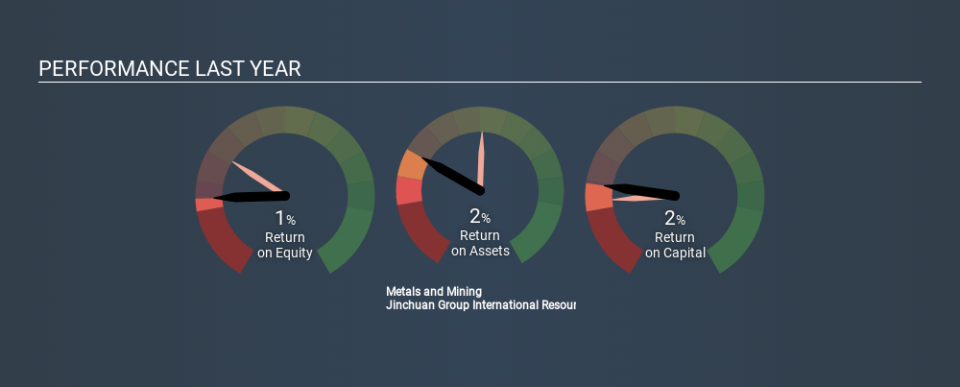Why Jinchuan Group International Resources Co. Ltd’s (HKG:2362) Use Of Investor Capital Doesn’t Look Great

Today we are going to look at Jinchuan Group International Resources Co. Ltd (HKG:2362) to see whether it might be an attractive investment prospect. Specifically, we'll consider its Return On Capital Employed (ROCE), since that will give us an insight into how efficiently the business can generate profits from the capital it requires.
First, we'll go over how we calculate ROCE. Then we'll compare its ROCE to similar companies. And finally, we'll look at how its current liabilities are impacting its ROCE.
Return On Capital Employed (ROCE): What is it?
ROCE measures the 'return' (pre-tax profit) a company generates from capital employed in its business. All else being equal, a better business will have a higher ROCE. In brief, it is a useful tool, but it is not without drawbacks. Renowned investment researcher Michael Mauboussin has suggested that a high ROCE can indicate that 'one dollar invested in the company generates value of more than one dollar'.
So, How Do We Calculate ROCE?
Analysts use this formula to calculate return on capital employed:
Return on Capital Employed = Earnings Before Interest and Tax (EBIT) ÷ (Total Assets - Current Liabilities)
Or for Jinchuan Group International Resources:
0.022 = US$33m ÷ (US$1.7b - US$242m) (Based on the trailing twelve months to December 2019.)
Therefore, Jinchuan Group International Resources has an ROCE of 2.2%.
Check out our latest analysis for Jinchuan Group International Resources
Is Jinchuan Group International Resources's ROCE Good?
When making comparisons between similar businesses, investors may find ROCE useful. In this analysis, Jinchuan Group International Resources's ROCE appears meaningfully below the 6.2% average reported by the Metals and Mining industry. This performance could be negative if sustained, as it suggests the business may underperform its industry. Independently of how Jinchuan Group International Resources compares to its industry, its ROCE in absolute terms is low; especially compared to the ~1.6% available in government bonds. Readers may wish to look for more rewarding investments.
Our data shows that Jinchuan Group International Resources currently has an ROCE of 2.2%, compared to its ROCE of 0.8% 3 years ago. This makes us think about whether the company has been reinvesting shrewdly. You can see in the image below how Jinchuan Group International Resources's ROCE compares to its industry. Click to see more on past growth.
Remember that this metric is backwards looking - it shows what has happened in the past, and does not accurately predict the future. Companies in cyclical industries can be difficult to understand using ROCE, as returns typically look high during boom times, and low during busts. ROCE is only a point-in-time measure. We note Jinchuan Group International Resources could be considered a cyclical business. If Jinchuan Group International Resources is cyclical, it could make sense to check out this free graph of past earnings, revenue and cash flow.
How Jinchuan Group International Resources's Current Liabilities Impact Its ROCE
Liabilities, such as supplier bills and bank overdrafts, are referred to as current liabilities if they need to be paid within 12 months. Due to the way ROCE is calculated, a high level of current liabilities makes a company look as though it has less capital employed, and thus can (sometimes unfairly) boost the ROCE. To counter this, investors can check if a company has high current liabilities relative to total assets.
Jinchuan Group International Resources has current liabilities of US$242m and total assets of US$1.7b. As a result, its current liabilities are equal to approximately 14% of its total assets. This is a modest level of current liabilities, which will have a limited impact on the ROCE.
Our Take On Jinchuan Group International Resources's ROCE
While that is good to see, Jinchuan Group International Resources has a low ROCE and does not look attractive in this analysis. You might be able to find a better investment than Jinchuan Group International Resources. If you want a selection of possible winners, check out this free list of interesting companies that trade on a P/E below 20 (but have proven they can grow earnings).
I will like Jinchuan Group International Resources better if I see some big insider buys. While we wait, check out this free list of growing companies with considerable, recent, insider buying.
If you spot an error that warrants correction, please contact the editor at editorial-team@simplywallst.com. This article by Simply Wall St is general in nature. It does not constitute a recommendation to buy or sell any stock, and does not take account of your objectives, or your financial situation. Simply Wall St has no position in the stocks mentioned.
We aim to bring you long-term focused research analysis driven by fundamental data. Note that our analysis may not factor in the latest price-sensitive company announcements or qualitative material. Thank you for reading.

 Yahoo Finance
Yahoo Finance 
